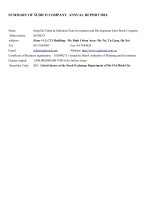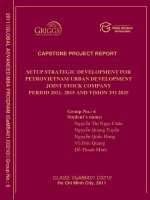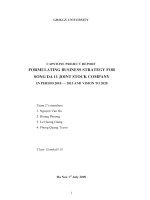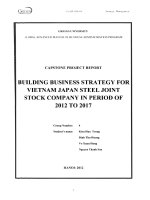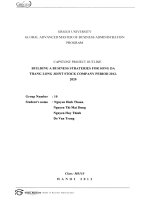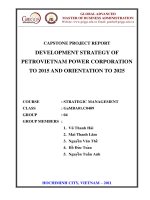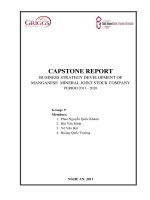Setup strategic development for petro VietNam urban development joint stock company period 2011- 2015 and vision to 2025
Bạn đang xem bản rút gọn của tài liệu. Xem và tải ngay bản đầy đủ của tài liệu tại đây (896.91 KB, 68 trang )
CAPSTONE PROJECT REPORT
SETUP STRATEGIC DEVELOPMENT FOR
PETROVIETNAM URBAN DEVELOPMENT
JOINT STOCK COMPANY
PERIOD 2011- 2015 AND VISION TO 2025
Group No.: 6
Student’s name:
Nguyễn Thị Ngọc Chân
Nguyễn Quang Tuyển
Nguyễn Quốc Hưng
Vũ Đức Quang
Đỗ Thanh Minh
CLASS: GaMBA01.C0210
Ho Chi Minh City, 2011
2011
GLOBAL ADVANCED MBA PROGRAM (GaMBA01.C0210)
Group No.: 6
GRIGGS UNIVERSITY
GLOBAL ADVANCED MASTER OF BUSINESS ADMINISTRATION PROGRAM
o0o
CAPSTONE PROJECT REPORT
SETUP STRATEGIC DEVELOPMENT FOR
PETROVIETNAM URBAN DEVELOPMENT
JOINT STOCK COMPANY
PERIOD 2011- 2015 AND VISION TO 2025
Group 6
Student’s name:
Nguyễn Thị Ngọc Chân
Nguyễn Quang Tuyển
Nguyễn Quốc Hưng
Vũ Đức Quang
Đỗ Thanh Minh
- 2011-
-2-
LIST OF FIGURES AND DIAGRAMS
- Figure 1: Set up business strategy framework 9
- Figure 1.1: Comprehensive strategic management by Fred R. David 11
- Figure 1.2: Five forces model by Michael Porter 15
- Figure 2.1: Organization chart of PVC - Mekong 24
- Figure 2.2: GDP index of Mekong Delta region 28
- Figure 2.3: GDP index of Can Tho city 29
- Figure 2.4: Economic structure of Can Tho 29
- Figure 2.5: Population and labor chart of Can Tho 31
- Figure 2.6: PetroVietnam’s portfolio in Mekong delta region 35
- Figure 3.1: Re-Organization chart of PVC-Mekong 63
-3-
LIST OF TABLES
Table 2.1: Business result of PVC-Mekong in 2008-2010 period 25
Table 2.2: Total revenue of PVC-Mekong 2009-2010 26
Table 2.3: GDP Index of Can Tho city 28
Table 2.4: Population and labor data of Can tho in 2008-2010 period 30
Table 2-5: GDP growth by sector in 2004-2009 period 33
Table 2.6: PVN portfolio in Mekong delta region 34
Table 2.7: Balance sheet of PVC-Mekong (2009 and 2010). 40
Table 2.8: Business result of PVC-Mekong (2009 and 2010) 40
Table 2.9: Business Index analysis of PVC-Mekong (2009 and 2010) 41
Table 2.10: PVC-Mekong External Factors Evaluation (EFE) 43
Table 2.11: PVC-Mekong Internal Factors Evaluation (IFE) 45
Table 2.12: Competitive Profile Matrix of PVC-Mekong 47
Table 2.13: SWOT Matrix of PVC-Mekong 48
Table 2.14: Quantitative Strategic Planning Matrix (QSPM) 50
-4-
TABLE OF CONTENT
INTRODUCTION 7
1. The need for thesis research 7
2. Research objective 8
3. Objects and scope of the study 8
4. Methodology 9
5. Structure of the study 9
CHAPTER 1 10
1.1. The concept of strategy and strategy management 10
1.1.1. The concept of strategy 10
1.1.2. The concept of strategy management 10
1.1.3. The role of Strategy management 11
1.2. Classification of business strategies 12
1.2.1. Corporation-level strategy 12
1.2.2. Strategic Business Unit (SBU) 12
1.2.3. Function-level strategy 13
1.3. Strategic management process 13
1.3.1. External evironment analysis 13
1.3.2. Macro environment 13
1.3.3. Analysis of industry environment (micro-environment) 15
1.4. Internal environment analysis 16
1.4.1. Human resources 17
1.4.2. Finance 17
1.4.3. Management Activities 17
1.5. Strategy tools 17
1.5.1. External Factor Evaluation (EFE) 18
1.5.2. Internal Factor Evaluation (IFE) 18
1.5.3. Competitive profile matrix (CPM) 18
1.5.4. SWOT matrix 19
-5-
1.5.5. Internal/External matrix (IE) 19
1.5.6. Quantitative Strategic Planning Matrix (QSPM) 20
CHAPTER 2 21
2.1. General information of PVC-Mekong 21
2.1.1. Company introduction 21
2.1.2. The PVC-Mekong organization structure 23
2.1.3. Operation Markets and the key partners of the Company 24
2.1.4. Business results of PVC-Mekong in three years (2008-2010) 25
2.2. Analysis of environmental factors affecting to the operations of the
Company 27
2.2.1. Macro Environment: 27
2.2.2. Micro Environment 36
2.3. Analysis of internal environment 39
2.3.1. Financial capability 39
2.3.2. Human Resource Management 41
2.3.3. Marketing 41
2.3.4. Product Quality 42
2.3.5. Leadership and management of the executive 42
2.3.6. External environmental evaluation matrix (EFE) 42
2.3.7. Internal environmental evaluation matrix (IFE) 45
2.3.8. Competitive Profile matrix of PVC-Mekong 47
2.3.9. SWOT Matrix 48
2.3.10. QSPM Matrix 49
2.4. Determine the need to develop strategies for PVC-Mekong 50
CHAPTER 3 53
3.1. Set up business strategy for PVC-Mekong 54
3.1.1. Development and investment strategy 55
3.1.2. Marketing and brand development strategy 56
3.1.3. Enterprise restructuring strategy 56
3.2. Implementing solutions 58
-6-
3.2.1. Developing investment solutions 58
3.2.2. Marketing and brand development solutions 58
3.2.3. Business restructuring solutions 60
-7-
INTRODUCTION
1. The need for thesis research
In the competitive situation taking place in all areas of business, if a company
would like to survive and develope in the marketplace, the most important and
necessary is to identify and orient business objectives, consistent with the frequent
changes and suddenly the business environment to ensure sustainable development
for business. Besides, Vietnam joined the World Trade Organization (WTO) and the
trend of globalization today, businesses are facing great opportunities to build and
develop a new level, while also facing the challenges and potential risks. To survive
and develop, businesses need to build their own orientations, appropriate business
strategy based on research, analysis of the external business environment, its
internal environment to be able to leverage opportunities and minimize the risk
from the business environment, as well as promoting the strengths and minimize the
weaknesses of the business.
Construction is a specific business, requiring special conditions such as strong
financial resources, ability to raise capital, good relationships with agencies and
specialized management function, the direction as well as long-term vision of
leaders. Construction activities also have a potential risk, but comes with big risks is
very attractive profit has attracted so many companies participate. The economy
structure of Mekong Delta region in general and Can Tho city in particular is
changing towards increasing industrial and construction. In particular, the projected
growth rate of the construction industry in 2011 will be getting 16.4% (period 1997-
2001 is 14.79%). In addition, forecasts of population growth of the Mekong Delta
during this period has increased about 22.1 million people with GDP expected to
7,755,000 VND /person/year. Since it can be seen the demand for housing, office
buildings, shopping centers, hotels, industrial parks, infrastructure for subsistence
needs and work of man will certainly increase in general and the Mekong Delta
-8-
region I general and Can Tho in particular, this is also the opportunity and challenge
of each enterprises in construction industry, including PVC-Mekong company.
Reference from the practical situation, to set up the business strategy for every
construction business is very essential, it helps the business has right way to
develop, clear business objectives, to direct every agencies and individuals to
general objectives of the business, avoiding sectional status, disperse the resources
that could be weakening the business. Today's business environment is rapidly
changing, globally competitive businesses always require active and creative to
adapt to such changes. That's the reason why group No 6 selected the subject “Set
up the developing strategies for PVC-Mekong Company in 2011-2015 and
orientation to 2025”.
2. Research objective
To systemize basis theoretical of the strategic for premise and analysis all of
factors affecting the company's operations, and set up strategy.
To assess the status of business operating of company, thereby determining the
results achieved as well as shortcomings in production and business activities of
company (from 2008 to 2010) which combined with the direction and objectives of
the business strategy to develop production and business activities of company in
the period 2011-2015 with a vision to 2025.
3. Objects and scope of the study
Object of the study is PetroVietnam Urban Development Joint Stock Company
(PVC-Mekong) that is a company has multi business lines in which the main field
of activity is the civil and industrial construction. Operating areas of the company is
mainly in Can Tho city and the neighboring provinces in the Mekong Delta region.
The range of research topics mainly focus on analyzing and evaluating business
environment of the PVC-Mekong in the period since its establishment in 2008 up to
-9-
now from which to build development strategies of the PVC-Mekong in 2011-2015
period and vision to 2025.
Figure 1: Set up business strategy framework
On analysis the PVC-Mekong business environment we focused on analyzing
the factors: economic, industry and internal environmential of the company.
On defined goals based on the previous period, current capacity and direction in
the coming years, then offers solutions and suggestions on development investment,
human resources, financial and production.
4. Methodology
- Desk research method: the information is collected from books, lectures,
specialized reports, newspapers, magazines, statistics, information from the
website
- Sources of internal information is the balance sheet, statement production
and business activities, the annual financial reports from 2008 to 2010.
- The thesis also uses meta-analysis method, comparative method, methods
experts to analyze the production and business operations of the company.
5. Structure of the study
Introduction
Chapter 1: Literature review
Chapter 2: Analyzing the business environment of PVC-Mekong
Chapter 3: Set up strategic business for PVC-Mekong
Conclusions and recommendations.
Environmental analysis
Set up Objectives
Propose solutions
-10-
CHAPTER 1
LITERATURE REVIEW
1.1. The concept of strategy and strategy management
1.1.1. The concept of strategy
The term strategy derives from the military field with the sense to point out the
large and long-term plans based on what is sure that the enemy can do, what the
enemy can not do. Since then the term business strategy was born, according to the
traditional strategy is to identify the fundamental long-term goals of an organization
from which to make concrete action plans with the use resources appropriately to
achieve the goals set forth.
According to Alfred Chandler: "The strategy includes the basic long-term
goals of an organization, and choose the measures or process of actions, allocate
resources necessary to implement those goals".
According to Michael E. Porter: "Strategy is the art of building a solid
competitive advantage to the defense."
1.1.2. The concept of strategy management
According to Alfred Chander:"Strategic management is the process of
determining the basic long-term goals of the organization, selection or way of
action and distribution of resources necessary to implement that goal."
According to Fred R. David: "Strategic management can be defined as an art
and science establishment, implementation and evaluation of decisions related
functionality allows an organization to achieve goals out ".
According to John Pearce II and Richard B. Robinson:"Strategic
management is a set of decisions and actions to establish and implement plans to
achieve business goals."
-11-
Figure 1.1: Comprehensive strategic management by Fred R. David
1.1.3. The role of Strategy management
Strategic management helps companies assess the current status of business
development, identifying opportunities and risks from external environment, the
strengths and weaknesses of the enterprise from which to promote the strengths,
minimize weaknesses, seizing opportunities and take measures to prevent threats
from outside. In addition, strategic management helps businesses define the purpose
and direction to be able to make business decisions in accordance with the business
environment in order to improve efficiency and productivity in production business
and competitive selection of appropriate business environment is always changing,
find out how to survive and grow to enhance the competitive position of enterprises.
Specific strategic management role as follows:
- The planning role: business strategy helps businesses find out the purposes
and their direction. It points out for the managers to review and determine
the direction should go and how and when to achieve the desired results.
-12-
- The prediction role: In a fluctuating environment, opportunities and risks
always appear at the same rate. Strategic planning process helps managers
analyze the business environment and give forecasts to make a reasonable
strategy. Thus managers can catch the opportunities better, take advantage of
the opportunities and reduce risks related to the business environment.
- The controlling role: business strategy could help the manager use and
distribute the available resources in the most effective way and coordinate
the functions of the organization efficiently to achieve set goals.
1.2. Classification of business strategies
1.2.1. Corporation-level strategy
Corporate-level strategy to identify and define the orientation of the
organization over the long term to complete tasks, achieve the growth target, for
example, focused growth strategy (market penetration, development market, new
product development), growth and integration strategy (front side and back side),
growth strategy to diversify (concentric, horizontal, mixed), strategic joint ventures,
etc. Based on firm level strategy, the organization will develop its own strategy.
1.2.2. Strategic Business Unit (SBU)
Strategic Business Unit (SBU) in a company can be a business or a product
category, etc. This strategy is aimed at the development of each sector or product
categories contributed complete the corporate strategy, must clearly identify the
advantages of each sector compared to the competitors to make the strategy
consistent with corporate strategic level, for example, differentiate strategy, strategy
costs low-defensive strategy to consolidate the market, offensive strategy for market
development. In market economies there is fierce competition, the marketing
strategy is considered the core strategic business unit level, acts as a link with the
strategy of the other functions.
-13-
1.2.3. Function-level strategy
The company has the functional departments such as marketing, human
resources, finance, manufacturing, research and development, etc. The department
should have a strategy to support the strategies implementation for business units
and corporate level, for example, marketing department has 4Ps strategy, human
resources department has a strategy to attract talent to the company, the finance
department with cost reduction strategies, investment strategies for new product,
etc… Function-level strategy valid in each period of the strategic business
implementation process of unit level and corporate level.
1.3. Strategic management process
1.3.1. External evironment analysis
Analyzing the external environment focused on the identification and
evaluation of trends with events beyond the control of the company, such as growth
of national economy, foreign competition, explosion of information technology
will show the opportunities and threats that an important experience to the
organization managers can draft strategy to take advantage of the opportunities and
avoid or reduce the image effects of such threats; External environment including
the macro environment and micro environment.
1.3.2. Macro environment
Macro environment factors including economic, legal, political and social
culture, geography and population, technology, nature, indirect impacts to business
operations. The impacts of the business to the group of factors is low, so companies
should choose the business environment for stable macro factors, especially
political issues and legislation to limit the risks . In addition, businesses also need
flexibility to change business policies as macro factors change. The analysis of the
macro environment to help businesses answer to the question: Enterprises are faced
with what?
-14-
1.3.2.1. Economic factors
Economic factors have a direct impact on the potential attractiveness of various
strategies. The influence of economic factors such as economic growth, inflation,
business cycles, the increase or decrease interest rates, stock prices, trends in the
value of the dollar, the tax system and tariff; etc
1.3.2.2. Legal and political factors
Legal and political factors more and more affect on the operation of the
business.
1.3.2.3. Social factors
All businesses have to analyze a wide range of social factors to determine the
opportunities and potential threats.
1.3.2.4. Natural factors
To analyze natural factors includes in considering the environmental pollution
problems, the energy become scarcer and scarcer, natural resources and minerals are
exploited indiscriminately, the quality of natural environment is at risk of
degradation, etc
1.3.2.5. Technology and technical factors
Technical progress can make new competitive advantages which are stronger
than the present advantages.
1.3.2.6. International factors
The trend of globalization, international economic integration and trade
liberalization are the outstanding issues of the world economy today. Strategists
need to utilize the advantages that globalization trend and international economic
integration give over, at the same time limiting the risks from the international
environment, which are the rival competitions.
-15-
1.3.3. Analysis of industry environment (micro-environment)
Micro-environment factors including industry factors and external factors of
business, deciding the nature and extent of competition in that industry, there are
five basic elements are: competitors, customers, suppliers, new potential
competitors and substitutes. To work out successful strategies need to analyze each
of the key factors that understanding the factors that help companies identify their
strengths weaknesses related to the opportunities and risks that the business that
encounter.
Figure 1.2: Five forces model by Michael Porter
(Source: Michael Porter, “Competitive Strategy”, 1980).
1.3.3.1. Competitors
Competitors are companies have the same kind of goods to the company,
competitors will share the market with the company, and it will pass if a higher
competitive advantage, the nature of competition in the industry to increase or
reduce dependence on market growth, investment and the level of competition.
-16-
1.3.3.2. Customers
Customers are part of the company, customer loyalty is created by the
satisfaction of customer needs and wants are better served and also a great
advantage for the company.
1.3.3.3. Suppliers
Enterprises have always associated with the vendor to be provided with
resources such as materials, equipment, labor, capital The provider may cause
pressure in the operation of the business, for should the research to provide
understanding of the business resources that can not be ignored in the process of
environmental studies.
1.3.3.4. New potential competitors:
New potential competitors are competitors could be enter the market in the
future and the formation of new competitors, which market share is, corporate
profits are falling, presence of competitors will affect the business strategies of
enterprises. So to analyze the potential rivals to assess the risks they create for
business
1.3.3.5. Substitutes
As other product names or components but giving utility customers the
equivalent of corporate products; the appearance of alternative products could lead
to reduced price risk and decline in corporate profits. Therefore businesses must
forecast and trend analysis to develop alternative products, identify all the risks that
the replacement product for business creation.
1.4. Internal environment analysis
Environmental analysis within the company is the identification and evaluation
of strengths and weaknesses in relation to the strategic level functions of the
-17-
company. To improve the company's weaknesses, making it a strong point, and if
possible, become the special ability of the company.
1.4.1. Human resources
Human is the most important resource of an organization. The objective of the
human resources strategic management is to develop a suitable staff planning with
the requirements of the company's strategy, both short and long term.
1.4.2. Finance
Financial condition is often considered as methods to evaluate the best
competitive position of the company and is the most attractive condition for
investors. Financial factors often influence to present strategies and plan
implementation. The functions of finance including: the ability to raise capital;
Financial risk management; Fertility interest.
1.4.3. Management Activities
Planning includes all administrative activities related to preparing for the
future. The specific duties are expecting, setting goals, advancing strategies,
developing policies and establishing goals.
Controlling relates to all management activities to ensure appropriate actual
results, consistent with the results which were planned, such as quality control,
financial control, sales, inventory, analyzing changes, ete
1.5. Strategy tools
According to Fred R David, the important techniques to form a strategy
consists of three phases, the tools used for this process can be applied to all sizes
and types of organizations, it help administrators can identify, evaluate and select
strategies, it is expressed through the following stages:
-18-
- Phase 1: Input phase included EFE Matrix, IFE matrix, CPM matrix, this
stage summarizes the basic information needed has been entered for the
formation of strategy.
- Phase 2: Call a combined phase out feasible strategies can be selected by
arranging, combining the elements inside, outside is important. At this stage
we choose one of the SWOT matrix, BCG matrix, In the subject the authors
only use BCG matrix and SWOT of the factors that combine to make the
appropriate strategy.
- Phase 3: Phase decided to include a technique is to use the Quantitative
Strategic Planning Matrix (QSPM) by using information entered at stage one,
to objectively evaluate feasible strategies can be selected in the second stage
from which to choose the appropriate strategy.
1.5.1. External Factor Evaluation (EFE)
External Factor Evaluation (EFE) matrix allows strategists to summarize and
evaluate the information of economic, social, cultural, demographic, geographic,
political, government, law, technology and competition. EFE matrix is a strategic
management tool commonly used to assess current business conditions. EFE matrix
is a good tool to visualize and prioritize the opportunities and threats that an
enterprise faces.
1.5.2. Internal Factor Evaluation (IFE)
Internal Factor Evaluation matrix (IFE) is a strategic tool to help business
summary and assessment of strengths and weaknesses of key business function, and
it also provides the basis to identify and assess the relationship between these
components.
1.5.3. Competitive profile matrix (CPM)
Competitive profile matrix (CPM) is a strategic management tool necessary to
make comparative evaluation of companies with major competitors in the industry,
-19-
the comparison is based on the factors affecting competitiveness of companies in
the industry. Thereby it gives the manager recognized the strengths and weaknesses
of the company with competitors, identify competitive advantages for the company
and weaknesses should be overcome.
IFE matrix is only evaluate internal factors and EFE matrix evaluate of external
factors, however CPM matrix evaluate both internal and external factors, the overall
assessment of the role and position of the company for the competitors.
1.5.4. SWOT matrix
SWOT matrix is used to list all the opportunities, risks, strengths and
weaknesses within the enterprise, in order and the appropriate position. Based on
the relationship between these factors, the analysis will be conducted to select
appropriate solutions through strategic combinations: strengths-opportunities (SO),
strengths-threats (ST), weaknesses-threat (WT) and weaknesses-opportunities
(WO). Depending on the business of that enterprise managers will use one or more
matrices to conduct SWOT analysis and solution options. SWOT groups are offered
four basic strategies:
- S-O: based on the strengths of the business to exploit outside opportunities.
- S-T: based on the strengths of the business to prevent or limit the threats
from the outside.
- W-O: These strategies reduce the internal weaknesses to take advantage of
external opportunities.
- W-T: These strategies reduce the internal weaknesses to prevent or limit the
outside danger.
1.5.5. Internal/External matrix (IE)
IE Matrix is a strategic management tool used to analyze the working
conditions and the strategic location of a business. Internal/external matrix or short
-20-
IE matrix is based on a short analysis of business factors internal and external
conditions that are combined into a model suggests.
1.5.6. Quantitative Strategic Planning Matrix (QSPM)
Quantitative Strategic Planning Matrix (QSPM) is a method to approach high
level strategic management to assess strategy; it can be use the input data from the
IFE, EFE, SWOT matrix and key strategic objective to evaluate the best strategic
alternative. QSPM method in step 3 of the strategic framework and building
analysis.
-21-
CHAPTER 2
THE BUSINESS ENVIRONMENT ANALYSIS OF PVC-MEKONG
2.1. General information of PVC-Mekong
2.1.1. Company introduction:
- Company name: PetroVietnam Urban Development Joint Stock Company
- Abbreviation name: PVC-Mekong
- Head office: No. 131, Tran Hung Dao street, An Phu Ward, Ninh Kieu
District, Can Tho City
- Chapter capital: 500 billion VND (Five hundred billion Vietnam dong)
PVC-Mekong was established on 02/2008 based on the comprehensive
development of cooperation between the National Oil Corporation and Vietnam Ca
Mau province. PVC-Mekong operates under the Business law, and performing the
tasks assigned by PetroVietnam Construction Company (PVC) to provide
construction services in Mekong Delta region, with the main following businesses:
- Engineering consultancy, urban design planning, construction investment
consultancy;
- Civil and industrial construction, urban and rural infrastructure, including
EPC contracts and turnkey contracts;
- Producing and trading construction materials;
- Real estate business
- Financial investments.
Design Consultancy is one of the first field operations of the company, the
design products created by PVC-Mekong are highly appreciated, affirmed its
impressive style. This area by Enterprise consulting and construction done, the
advisory function of investment and construction investment project, procurement
consulting, consultancy and supervision of project management, consultancy device
-22-
technology consultancy topographical, geological, surveying work; experimental
design; examination of investment projects, technical designs and total cost
estimates for planning and control quality of works, etc However, due to the
policy of developing internal resources, use of services in the Oil and Gas Industry
of PetroVietnam (PVN), PVC-Mekong was appointed as EPC contractor to perform
a number of key projects which invested by PVN, all resources of the PVC-Mekong
focus on the implementation of these projects to achieve superior results, step by
step as confirmed role of PVC-Mekong. Thus, the proportion of consultancy work
in the outside market is very low, and the competitiveness of the market
consultation in the area of the company is not high.
In the field of construction and installation, PVC-Mekong efforts to growth as
well as with the sustainable development goal strategies, maximum satisfy the
needs of customers, continue investing new equipments and apply advanced
technology in construction. With nearly 300 well-qualified forces personnel,
experienced and skillful staffs, engineers, specialists and workers, PVC-Mekong
has mastered many modern technological construction, ready to meet the rigorous
requirements in construction, and PVC-Mekong trademark has been affirmed in the
construction market, get fully belief from the investors. Construction market of the
company now also focuses on projects invested by the petroleum industry in the
form of appointment, has not penetrated the market outside the Petroleum industry.
Building material production plays an important role, helps to provide material
for construction projects and shortens construction time actively and has sustainable
development for the entire company. The industrial production products of PVC-
Mekong are crucial to social life, with high technology, are produced in the modern
technology lines and have competitiveness in the market such as: commodity
concrete, precast concrete and other products. The company's products are mainly
provided for the projects that PVC-Mekong is implementing.
At present, the investment and real estate business field of PVC-Mekong
undeveloped but it is the long-term development strategy of the PVC-Mekong. In
-23-
the coming years, real estate business is one of the main activities of the company.
Besides profits, this sector also supports the construction field, industrial building
materials and other fields to develop.
With long-term development, financial investment an important field of
activity, PVC-Mekong will actively participate in the currency market. The funding
channels will be done through strengthening the internal accumulation of retained
earnings, increasing charter capital, issuing more shares, corporation bonds, project
bonds and attracting capital from the outside stock. At the moment this function has
not been implemented to promote strongly, with long-term development strategy
this area will be focused to develop by PVC-Mekong.
2.1.2. The PVC-Mekong organization structure
PVC-Mekong is an economic unit, which has independence finance, legal
status, own seal in the form prescribed by the State and the account opened at the
bank. The company takes responsibility for the results of its operations, ensures the
accumulated interest, expands business, preserves capital and takes financial
obligations of the State.
The organizational structure of PVC-Mekong started from the Director Board,
where planning all the strategies of the company, making important decisions about
the development and investment of the company. PVC-Mekong has 4 functional
departments, 1 project management board, 3 firms and 13 construction teams
arranged by online functional organization structure to take advantage of the online
structure and the functional structure and allow young leaders chances to develop
their ability and their leadership. However, this structure also exist some
disadvantages such as unclear responsibility, a lot of controversies and requires a
specific solution to overcome this problem.
-24-
Shareholders Committee
Board of Director
Director
Supervisory
Board
Vice Director
(Trade & Planning)
Vice Director
(Technical)
Vice Director
(Project)
Planning Dept
Financial Dept
Technical Dept
Administrative Dept
Projet management
Board
Housing
Management Firm
Mechanical
construction Firm
Construction
Executing Firm
Engineering
consultancy Firm
Preschool
Figure 2.1: Organization chart of PVC-Mekong
2.1.3. Operation Markets and the key partners of the Company
Main market of PVC-Mekong is the Mekong Delta region and some
neighbouring provinces, in recent years PVC-Mekong mainly has activities in Ca
Mau, Bac Lieu, Soc Trang, Hau Giang, Can Tho and Tien Giang. The key projects
implemented by the company are mainly invested by the Vietnam Oil and Gas
Group (PVN) and the member unit, the rest (very little) is invested by local (mainly
in Ca Mau).
Major partners of the PVC-Mekong are mainly members of Vietnam Oil and
Gas Group (PVN) and the petroleum industry units that PVN may contribute
capital. Work sources in the company mainly from two sources: directly specified
and implemented as the task from the mother company-PetroVietnam Construction
Company (PVC).
